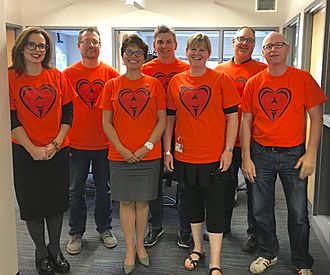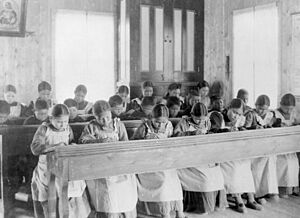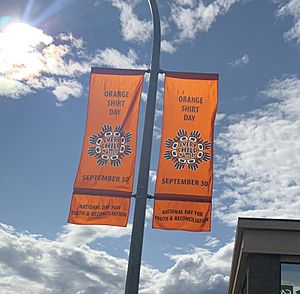National Day for Truth and Reconciliation facts for kids
Quick facts for kids Truth and Reconciliation Day |
|
|---|---|

Teachers in a Canadian school wearing orange shirts for Orange Shirt Day
|
|
| Also called | Orange Shirt Day |
| Type | Historical, memorial |
| Significance | National day to recognize the impact of the Canadian Indian residential school system |
| Date | September 30 |
| Frequency | Annual |
| First time | 2013 (Orange Shirt Day) 2021 (Truth and Reconciliation Day) |
| Started by | Phyllis Webstad |
The Truth and Reconciliation Day (also known as Journée de la vérité et de la réconciliation in French) is a special Canadian holiday. It is also often called Orange Shirt Day (Jour du chandail orange). This day helps Canada remember the lasting effects of the Canadian Indian residential school system.
Orange Shirt Day started in 2013. It was created to teach people about the residential school system. It also aimed to show how these schools affected Indigenous communities for over 100 years. The harm caused by these schools is seen as a "cultural genocide." This means it was an attempt to destroy Indigenous cultures.
The orange shirt symbol comes from a story shared by Phyllis Jack Webstad. When she was a child, her new orange shirt was taken from her on her first day at a residential school. She never got it back. So, the orange shirt now stands for how Indigenous children were forced to give up their culture.
In 2021, the Canadian government made this day a national holiday. They named it Truth and Reconciliation Day. This happened after more than 1,000 unmarked graves were found near former residential school sites. This day is now a holiday for many workers across Canada.
Contents
Understanding Residential Schools
What Were Residential Schools?
After Canada became a country in 1867, its leaders took on a big responsibility. They had to deal with agreements made with the First Nations. Prime Minister John A. Macdonald wanted to unite Canada. He aimed to blend First Nations people into Canadian society and erase their cultures.
In 1878, he asked Nicholas Flood Davin to study schools in the United States. Davin reported that only residential schools could separate Indigenous children from their families. He said these schools could make children "merged and lost" within the nation. He suggested the government work with Christian churches to open these schools.
Starting in 1883, the government began funding these schools. Most were run by the Roman Catholic Church and the Anglican Church. Other churches like the United, Methodist, and Presbyterian Churches also ran some. When parents did not want to send their children, the government made school attendance mandatory in 1894. The Royal Canadian Mounted Police could even take children from their homes. A "pass system" was also created. It stopped Indigenous people from leaving their reserves without permission.
Life in Residential Schools
Conditions in these schools were very difficult. The schools did not have enough money. Diseases like tuberculosis spread easily. Over more than 100 years, about 150,000 children went to residential schools. The Truth and Reconciliation Commission of Canada found records of about 3,200 children who died there. However, Justice Murray Sinclair, who led the Commission, believes the real number could be as high as 6,000.
Most recorded deaths happened before the 1950s. Tuberculosis was the main cause of death. But children also died from other illnesses, fires, accidents, drowning, and cold. Some deaths happened while children tried to run away. Some schools had very high death rates, over 30%. These rates were much higher than for other Canadian children. Many deaths were due to neglect. Schools often did not give basic medical care until it was too late. Staff sometimes waited a day to look for missing children.
Dr. Peter Bryce reported on the high death rates in 1897. His report was shared with journalists, leading to calls for change. But his suggestions were mostly ignored. Duncan Campbell Scott, a government official, supported the assimilation policy. In 1910, he said that Indigenous children lost their natural resistance to illness in these schools. He noted they died at a much higher rate. But he felt this did not justify changing the policy.
Many schools did not tell families when children died. They buried children in unmarked graves. For one-third of recorded deaths, the names of the children were not even written down. In some schools, students were forced to work to raise money. Children were also beaten for speaking their Indigenous languages.
By the 1950s, the government started to ease rules on First Nations. They also began closing the schools. The government took control from the churches in 1969. By the 1980s, only a few schools were left. The very last school closed in 1996.
The Path to Truth and Reconciliation
Apologies and Investigations
In 1986, the United Church of Canada said sorry for its part in the residential school system. The Anglican Church did the same in 1992. Some Catholic groups have apologized. In 2009, Pope Benedict XVI expressed sadness for survivors' experiences. But the Roman Catholic Church had not formally apologized for its role. In 2017, Prime Minister Justin Trudeau asked the Pope to apologize.
In 1991, the Royal Commission on Aboriginal Peoples was created. It looked into the relationship between Indigenous peoples, the government, and Canadian society. Its report in 1996 led the government to make a statement of reconciliation in 1998. It also set up the Aboriginal Healing Foundation.
Prime Minister Stephen Harper apologized in 2008 on behalf of the government. He created the Truth and Reconciliation Commission of Canada. This commission was set up to find out what truly happened at the schools. The commission released its final report in 2015. It found that the residential school system was an act of "cultural genocide". It stopped parents from teaching their children Indigenous languages. This led to 70% of Canada's Indigenous languages being at risk. The report also found that the poor education in these schools harmed Indigenous people. It affected their future incomes and the education of their children and grandchildren.
How Orange Shirt Day Began
Orange Shirt Day was inspired by Phyllis Jack Webstad. She shared her story in 2013 at an event in Williams Lake. Phyllis told how, at six years old, she had her clothes taken away on her first day at residential school. This included a new orange shirt from her grandmother. The shirt was never returned. This orange shirt now represents how the residential school system tried to take away Indigenous identities. The color orange also has old ties to First Nations. It stands for sunshine, truth, health, and strength.
Today, Orange Shirt Day continues the legacy of that 2013 event. September 30 is the yearly date. This date marks the time of year when Indigenous children were historically taken from their homes. The day's slogan, "Every Child Matters," reminds everyone that all cultures are important.
People are encouraged to learn about residential schools and their assimilation practices. Many communities hold memorial walks, show films, and give public talks. These events raise awareness about Indigenous history. Schools across Canada are also using this day to teach children about the system.
Becoming a National Holiday
In 2017, government ministers encouraged Canadians to take part in Orange Shirt Day. The next year, the government thought about making it a national holiday. September 30 was one of the dates considered. A bill was proposed in Parliament to make Orange Shirt Day a holiday. It passed in the House of Commons in 2019. But it did not become law before an election.
In 2020, a new bill was proposed. It suggested Orange Shirt Day become a national holiday. It would be called the National Day for Truth and Reconciliation. On May 28, 2021, news broke about the discovery of 215 possible remains. These were found in an unmarked cemetery at the former Kamloops Indian Residential School. After this, all parties in Parliament quickly agreed to pass the bill. It became law on June 3, 2021.
On September 30, 2021, Queen Elizabeth II of Canada sent a message. She said she joined all Canadians in reflecting on the painful history of residential schools. She also spoke about the work needed to heal and build an inclusive society.
Films and TV Shows
On October 11, 2020, CBC Television and the Aboriginal Peoples Television Network aired a special. It was called Every Child Matters: Reconciliation Through Education. This show shared stories of residential school survivors. It was made to mark Orange Shirt Day.
Phyllis Webstad's story was featured in the 2021 film Returning Home. In September 2021, CBC Television also showed the documentary We Know the Truth: Stories to Inspire Reconciliation.
Official Orange Shirts
The Orange Shirt Society was created by the people who started Orange Shirt Day. It is based in Williams Lake, British Columbia. Each year, they release an official Orange Shirt Day T-shirt. It features a design by an Indigenous artist and the slogan "Every Child Matters." Money from shirt sales goes to the Orange Shirt Society.
In 2017, there were not enough official orange shirts for everyone who wanted one. So, some communities made their own. Designer Carey Newman made a shirt that sold out very quickly. His father had attended a residential school, and his design honored this.
The Orange Shirt Society now allows other Indigenous artists to create orange shirts. They ask that some of the money from these shirts goes to the Orange Shirt Society or other Indigenous charities.




